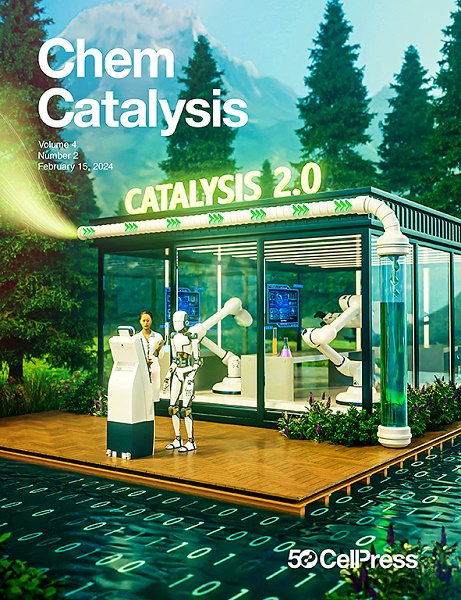Paired electrochemical synthesis of glycolic acid and ammonia from polyester and nitrate sewage
IF 11.6
Q1 CHEMISTRY, PHYSICAL
引用次数: 0
Abstract
Electrochemical upcycling of nitrate (NO3−) wastewater to ammonia offers a sustainable route for reclaiming nitrogen resources from waste. However, its practical implementation still faces substantial obstacles, including high energy input and limited selectivity. Here, we report a paired electrochemical system that combines the anodic oxidation of polyethylene terephthalate (PET) hydrolysate, specifically its ethylene glycol (EG) monomer, to glycolic acid (GA) with the cathodic reduction of NO3− to ammonia. All of this is made possible by the discovery of a PdCu alloy anode and a CuCo alloy cathode. Built upon experimental demonstration and a theoretical understanding of the improved CO resistance on the PdCu alloy for EG oxidation, as well as the synergy between Cu and Co for NO3− reduction, our paired system enables the efficient co-production of GA and ammonia from PET hydrolysate and NO3−-containing wastewater. This conceptual design of paired electrochemistry provides an intriguing way to synthesize high-value chemicals from waste resources.

从聚酯和硝酸盐污水中配对电化学合成乙醇酸和氨水
硝酸(NO3−)废水电化学升级回收制氨为废物氮资源的可持续利用提供了一条途径。然而,其实际应用仍面临着能量输入高、选择性有限等重大障碍。在这里,我们报道了一个配对的电化学系统,结合了聚对苯二甲酸乙二醇酯(PET)水解物的阳极氧化,特别是它的乙二醇(EG)单体,生成乙醇酸(GA)和NO3−的阴极还原成氨。所有这一切都是通过发现PdCu合金阳极和CuCo合金阴极而实现的。基于对PdCu合金抗氧化能力提高的实验论证和理论理解,以及Cu和CO对NO3−还原的协同作用,我们的配对系统能够从PET水解物和含NO3−的废水中高效地协同生产GA和氨。这种配对电化学的概念设计为从废物资源合成高价值化学品提供了一种有趣的方法。
本文章由计算机程序翻译,如有差异,请以英文原文为准。
求助全文
约1分钟内获得全文
求助全文
来源期刊
CiteScore
10.50
自引率
6.40%
发文量
0
期刊介绍:
Chem Catalysis is a monthly journal that publishes innovative research on fundamental and applied catalysis, providing a platform for researchers across chemistry, chemical engineering, and related fields. It serves as a premier resource for scientists and engineers in academia and industry, covering heterogeneous, homogeneous, and biocatalysis. Emphasizing transformative methods and technologies, the journal aims to advance understanding, introduce novel catalysts, and connect fundamental insights to real-world applications for societal benefit.

 求助内容:
求助内容: 应助结果提醒方式:
应助结果提醒方式:


